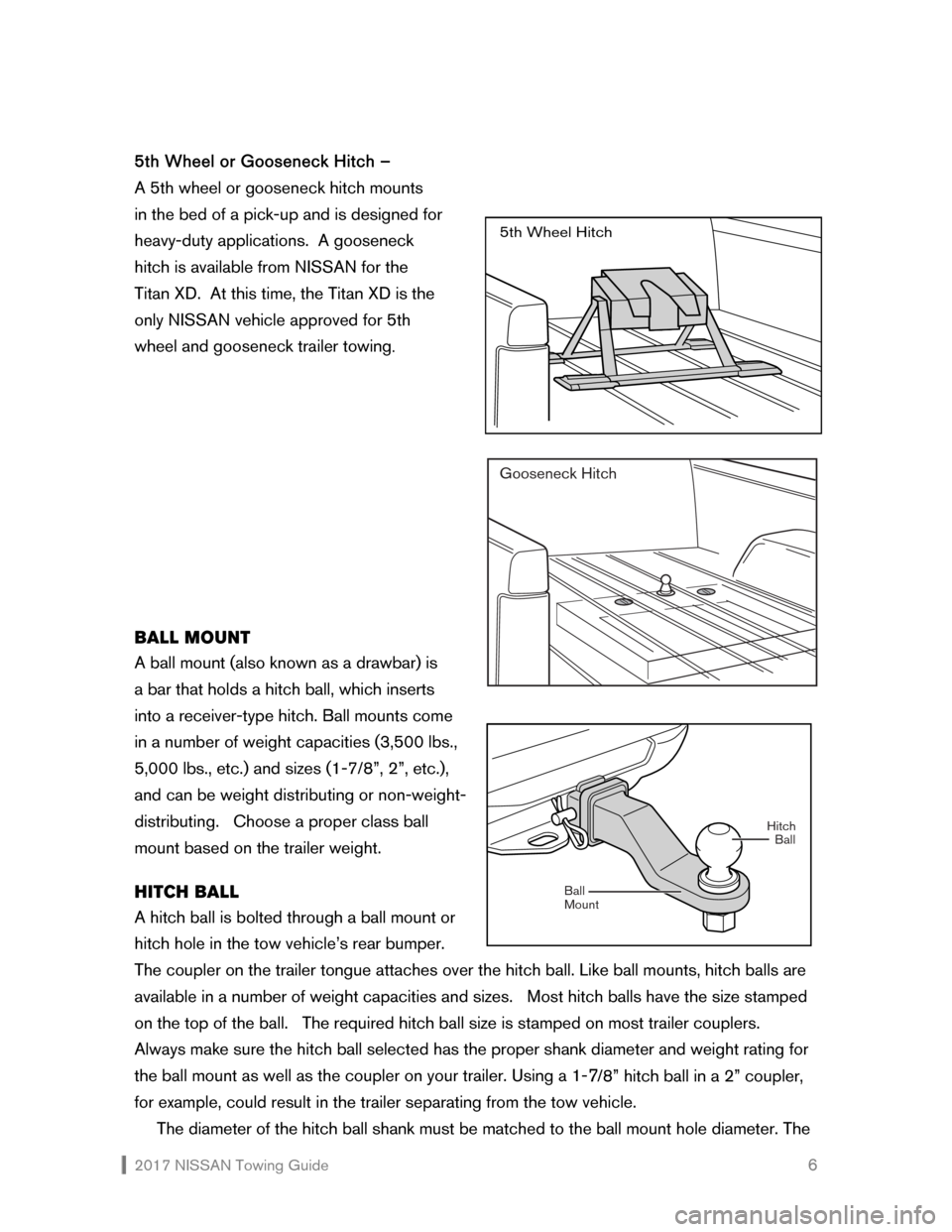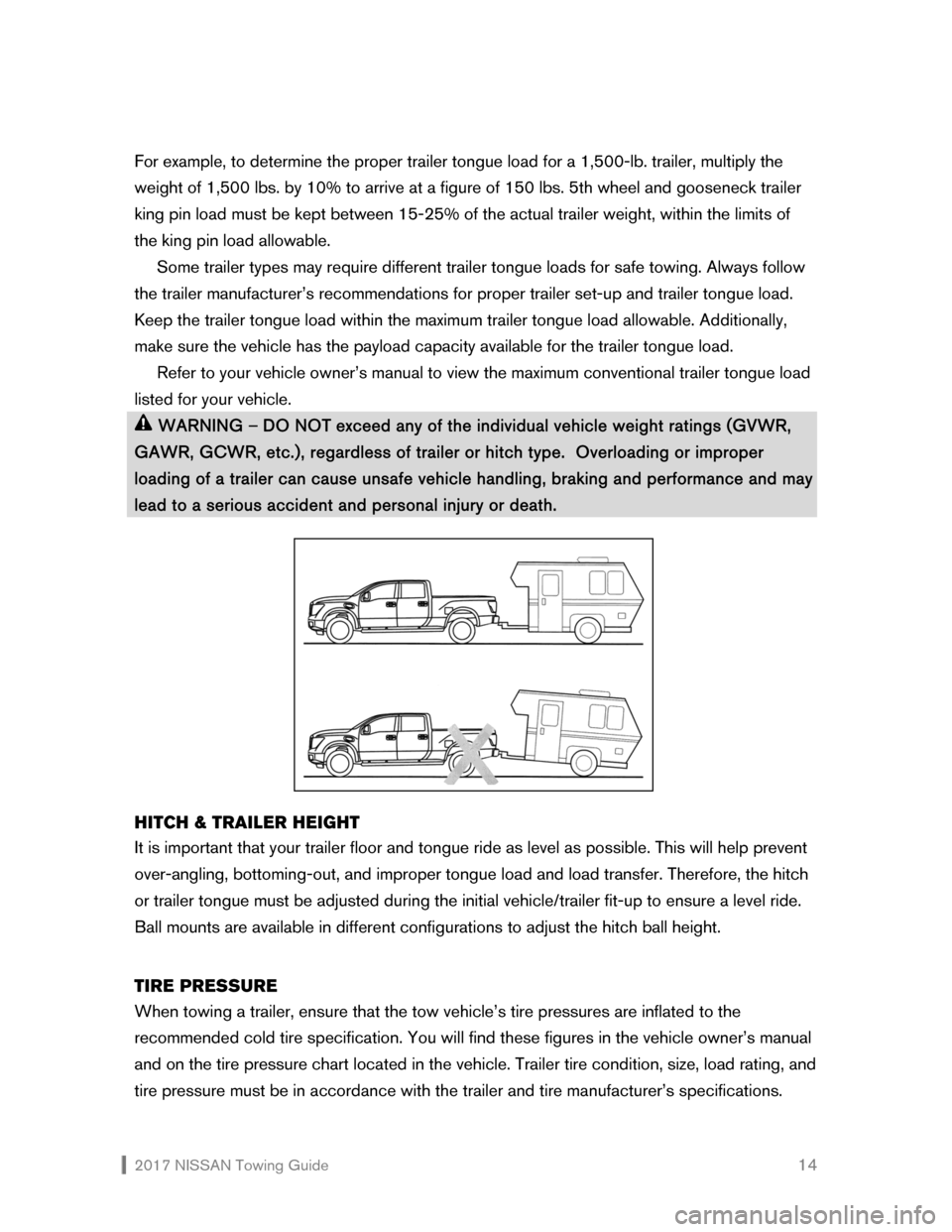Page 7 of 27

2017 NISSAN Towing Guide 6 5th Wheel or Gooseneck Hitch –
A 5th wheel or gooseneck hitch mounts
in the bed of a pick-up and is designed for
heavy-duty applications. A gooseneck
hitch is available from NISSAN for the
Titan XD. At this time, the Titan XD is the
only NISSAN vehicle approved for 5th
wheel and gooseneck trailer towing
.
BALL MOUNT
A ball mount (also known as a drawbar) is
a bar that holds a hitch ball, which inserts
into a receiver-type hitch. Ball mounts come
in a number of weight capacities (3,500 lbs.,
5,000 lbs., etc.) and sizes (1-7/8”, 2”, etc.),
and can be weight distributing or non-weight-
distributing. Choose a proper class ball
mount based on the trailer weight.
HITCH BALL
A hitch ball is bolted through a ball mount or
hitch hole in the tow vehicle’s rear bumper.
The coupler on the trailer tongue attaches over the hitch ball. Like ball mounts, hitch balls are
available in a number of weight capacities and sizes. Most hitch balls have the size stamped
on the top of the ball. The required hitch ball size is stamped on most trailer couplers.
Always make sure the hitch ball selected has the proper shank diameter and weight rating for
the ball mount as well as the coupler on your trailer. Using a 1-
7/8” hitch ball in a 2” coupler,
for example, could result in the trailer separating from the tow vehicle.
The diameter of the hitch ball shank must be matched to the ball mount hole diameter. The
5th Wheel Hitch
Gooseneck Hitch
Hitch
Mount BallBall
Page 15 of 27

2017 NISSAN Towing Guide 14
For example, to determine the proper trailer tongue load for a 1,500-lb. trailer, multiply the
weight of 1,500 lbs. by 10% to arrive at a figure of 150 lbs. 5th wheel and gooseneck trailer
king pin load must be kept between 15-25% of the actual trailer weight, within the limits of
the king pin load allowable.
Some trailer types may require different trailer tongue loads for safe towing. Always follow
the trailer manufacturer’s recommendations for proper trailer set-up and trailer tongue load.
Keep the trailer tongue load within the maximum trailer tongue load allowable. Additionally,
make sure the vehicle has the payload capacity available for the trailer tongue load.
Refer to your vehicle owner’s manual to view the maximum conventional trailer tongue load
listed for your vehicle.
WARNING – DO NOT exceed any of the individual vehicle weight ratings (GVWR,
GAWR, GCWR, etc.), regardless of trailer or hitch type. Overloading or improper
loading of a trailer can cause unsafe vehicle handling, braking and performance and may
lead to a serious accident and personal injury or death.
HITCH & TRAILER HEIGHT
It is important that your trailer floor and tongue ride as level as possible. This will help prevent
over-angling, bottoming-out, and improper tongue load and load transfer. Therefore, the hitch
or trailer tongue must be adjusted during the initial vehicle/trailer fit-up to ensure a level ride.
Ball mounts are available in different configurations to adjust the hitch ball height.
TIRE PRESSURE
When towing a trailer, ensure that the tow vehicle’s tire pressures are inflated to the
recommended cold tire specification. You will find these figures in the vehicle owner’s manual
and on the tire pressure chart located in the vehicle. Trailer tire condition, size, load rating, and
tire pressure must be in accordance with the trailer and tire manufacturer’s specifications.
Page 24 of 27

2017 NISSAN Towing Guide 23
GROSS AXLE
WEIGHT RATING (GAWR) The maximum amount of weight each vehicle axle (front and rear) is
designed to safely carry.
GROSS COMBINED
WEIGHT RATING (GCWR) The maximum allowable combined weight of the vehicle and trailer,
including passengers and all cargo.
GROSS VEHICLE
WEIGHT RATING (GVWR) The maximum allowable weight of the vehicle, including passengers, cargo,
fuel, hitch, trailer tongue load, and any optional equipment.
KING PIN
LOAD The amount of trailer (5th wheel or gooseneck) weight pressing down on the
tow vehicle hitch.
HITCH BALL
A ball that connects the trailer to the tow vehicle hitch that provides the
means by which the trailer pivots during cornering. Available in a number
of sizes and weight capacities, it must correspond to the trailer coupler
size, and have a sufficient capacity rating for the trailer being pulled.
RECEIVER HITCH A frame- or structure-mounted hitch with a receiver that allows removal of
the ball mount.
SAFETY CHAINS/CABLES Provides an emergency connection between the tow vehicle and the trailer,
should the trailer become disengaged for any reason.
SURGE BRAKES
Hydraulic-type braking system activated by inertia. As the tow vehicle
begins to brake, the trailer pushes against the hitch ball, consequently
activating the trailer brakes.
TRAILER LIGHT CHECK The system allows you to visually check the trailer brake lights as you cycle
through them, controlled by the Intelligent Key.
TRAILER TONGUE/COUPLER The part of the trailer that extends forward to meet the tow vehicle, and
carries the coupler assembly.
TRAILER TONGUE
LOAD
The amount of trailer (conventional) weight pressing down on the tow
vehicle hitch.
WEIGHT-DISTRIBUTING
HITCH SYSTEM Type of hitch system that helps shift the trailer tongue weight to all trailer
tires and the tow vehicle front tires. Strongly recommended when towing
trailers with a Maximum Trailer Weight greater than 5,000 lbs.
WIRING HARNESS Provides an electrical connection linking the tow vehicle’s electrical system
to the trailer’s system.